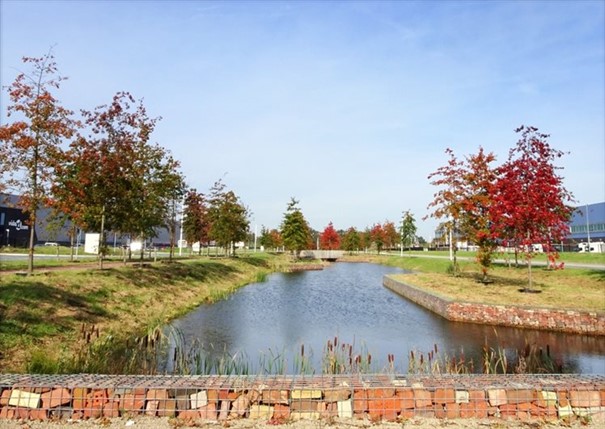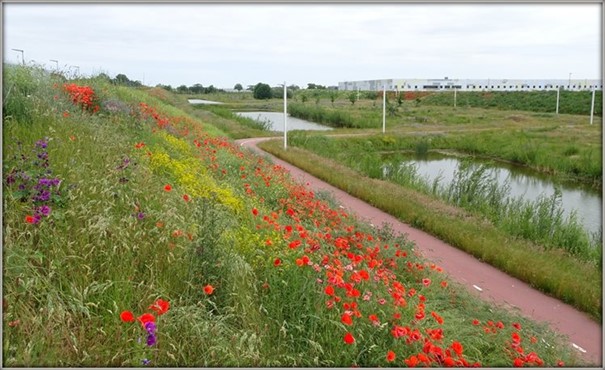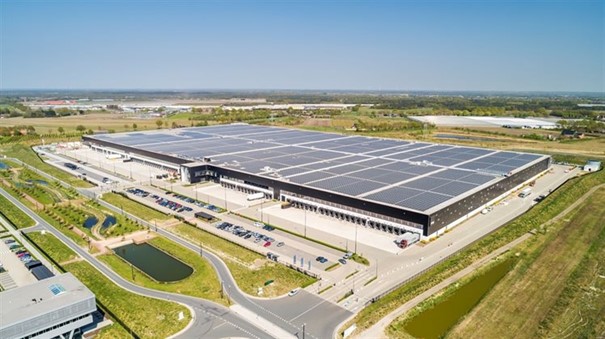Greenport Venlo offers a climate adaptive and biodiverse working landscape
Northwest of the city of Venlo lies Greenport Venlo. This area was once used as farmland, accommodating cattle farms. Since 2012, the area has developed into a climate adaptive and nature inclusive working landscape. In 2022, Greenport Venlo even made the top three of most climate adaptive and nature inclusive industrial estates of the year.
What has prompted the creation of Greenport Venlo?
In 2012, the province of Limburg and the municipalities of Venlo, Horst aan de Maas, and Venray drew up a framework vision and a landscape plan for the area. This set out that approximately 400 hectares of land would be used as a business park, whilst another 400 hectares would be designed as a nature reserve and landscape area. This plan was aimed at helping to turn this region into a growth area rather than a depopulating area: an area featuring job opportunities for young people and a green environment with room for cycling, walking, and sports.
What measures have been taken?
Development company Ontwikkelbedrijf Greenport Venlo is responsible for the operational management and development of the area. Since 2012, the company has implemented the following adaptation measures:
- Ponds have been created in between the business premises, along Greenport lane provincial road, and at other spots in the area. The ponds form a single water system in which rainwater is retained, drained into the soil or discharged into existing brooks. The design of the water system is geared to the collection capacity of the existing brooks.
- More than thirty per cent of the total surface area of the business park will remain vacant. Here, rainwater can drain into the soil. Rainwater that falls on paved areas and business park roofs will flow to the nearest pond via roadsides, ditches or underground pipes.

The measures help to combat waterlogging and slow down soil dehydration during periods of drought. Thus, groundwater levels will remain constant or rise. The district water board is monitoring the situation by continuously measuring groundwater levels at several locations. Furthermore, the ponds and greenery at various locations in between the businesses will combat heat stress. They also provide employees and visitors with pleasant spots for eating lunch or taking a walk.
Attention for biodiversity
In addition to climate adaptation, the Greenport Venlo area sets great store by promoting biodiversity, as is apparent from the following measures and results:
- Clearing plots for building produces garden mould. The Ontwikkelbedrijf company uses this mould to create embankments, in order for the businesses to blend in with the surrounding landscape. These embankments are sowed with a special mixture of herbs that attracts insects and birds. The embankments are managed by shepherds. Grazing sheep here will distribute the flower seeds further afield. This works out, because beekeepers and environmentalists have observed an increase in bee and insect species in the area.
- The ponds attract different bird species, e.g., swans, ducks, and cormorants. Furthermore, birds use the flat rooftops within the business park to nest. A local bird watcher has observed increasingly more bird species in the area.
- A fauna tower has been put up for bats and sparrows, as has a nesting box for owls. In addition, badger-safe routes have been created and (artificial) setts have been built.
- In addition to the landscape plan, the area is covered by an incentive scheme entitled “Groene Dorpsmantel”. Under this scheme, residents of the municipality of Horst aan de Maas who own a piece of land near Greenport Venlo qualify for financial support for green measures, provided that the location and the planting plan meet the conditions.

Reducing CO₂ emissions
Construction at Greenport Venlo needs to be gas-free, in order to minimise CO₂ emissions. In addition, the eight wind turbines in Greenport Venlo Wind Farm generate green energy to power some thirty thousand households. In 2024, a ninth wind turbine will be added. The solar panels on the business park roofs produce green energy for 19,000 households. Furthermore, the area features a new rail terminal with a loading and unloading capacity of twelve trains per day. This reduces the need for lorries, which will further reduce CO₂ emissions. Finally, a cycling network has been constructed to encourage employees to leave their cars at home and take the (electric) bicycle to work.
Lessons to be learned
Greenport Venlo has been operational for ten years now. The development of this area has generated the following lessons to be learned:
- Close collaboration between various government bodies, from day one, has proven important. Such collaboration has produced many advantages in drawing up the framework vision and the landscape plan.
- It is good to involve local residents in the conception and implementation of new plans. At Greenport Venlo, contact with residents has resulted in, e.g., higher embankments, agreements on plants to cover the embankments, and solutions to light nuisance.
- When constructing new business premises, it is wise to factor in employee well-being. For example, employees will appreciate an office overlooking greenery, water, and wildlife.
- A green environment raises the real estate value of business premises.

